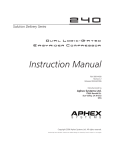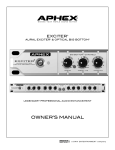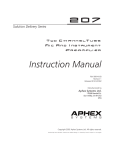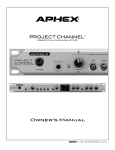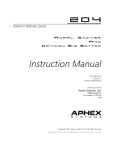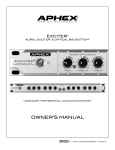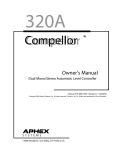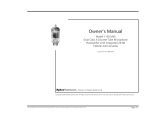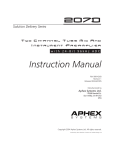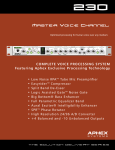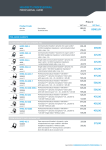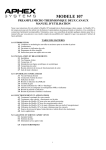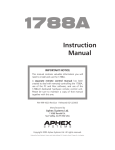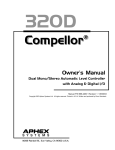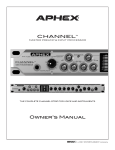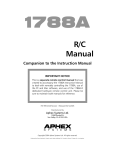Download Aphex 228 Instruction manual
Transcript
228 unidirectional audio interface 8-CH A N N E L C O N S U M E R t o P R O L E V E L I N T ERFACE [ - 1 0 d B V U NBALANCED IN to +4dBu BALANCED OUT] S Y S T E M S THE SOLUTION DELIVERY SERIES Solution Delivery Series 228 8-channel unidirectional audio Interface Instruction Manual P/N 999-4180 Revision 1 Released 01/28/2004 Manufactured by Aphex Systems Ltd. 11068 Randall St. Sun Valley, CA 91352 USA S Y S T E M S Copyright 2004 Aphex Systems Ltd. All rights reserved. Produced by: Donn Werrbach. Creation tool: Adobe InDesign 2.0. Printed by: Stuart F. Cooper Co., Los Angeles. 228 instruction Manual A MESSAGE FROM THE PRESIDENT Dear Aphex customer, Thank you for selecting the Model 228 as your interface between consumer level outputs and professional level inputs. By using this interface you will improve the sonic performance of your installation - setting levels for exact balancing between different channel outputs and devices will be very quick and simple, gain structure will be idealized for the lowest noise, and balanced lines will make your system more immune from induced noise. Even though the Model 228 is a relatively simple design there was a great deal of research and thought that went into its development. We trust that you will find its performance and features equal to what you have come to expect from all Aphex products. Very truly yours, Marvin Caesar Safety Declarations CAUTION: For protection against electric shock, do not remove the cover. No user serviceable parts inside. WARNING: This equipment has been tested and found to comply with the limits for a Class A digital device pursuant to Part 15 of the FCC Rules. These limits are designed to provide reasonable protection against harmful interference when the equipment is operated in a commercial environment. This equipment generates, uses, and can radiate radio frequency energy and, if not installed and used in accordance with the operating guide, may cause interference to radio communications. Operation of this equipment in a residential area is likely to cause interference in which case the user will be required to correct the interference at his own expense. The user is cautioned that changes and modifications made to the equipment without approval of the manufacturer could void the user’s authority to operate this equipment. It is suggested that the user use only shielded and grounded cables to ensure compliance with FCC Rules. | Conforms to standards UL60950 and EN60950. ® C US 59887 Page 2 Aphex Systems Ltd. Model 228 Copyright 2004 by Aphex Systems, LTD. All rights reserved. All Aphex products are trademarks or registered trademarks of Aphex Systems, LTD. Other brand and product names are trademarks or registered trademarks of their respective holders. 8-channel audio interface 228 Table of Contents 1.0 QUICK START - Page 4 2.0 INSTALLATION - Page 6 2.1 Mounting 2.2 Rear Panel View 2.3 AC Line Connection 2.4 Input Connectors 2.5 Output Connections 3.0 CONTROLS AND INDICATORS - Page 7 3.1 Front Panel View 3.2 Meter and Indicator Window 3.3 Meter Select Button 3.4 Interface Gain Trimmers 4.0 SPECIFICATIONS - Page 8 4.1 General Specifications 42 Architectural Specifications 5.0 WARRANTY AND SERVICE - Page 10 51 Limited Warranty 52 Service Information 6.0 APPENDICES - Page 11 Appendix A - Introduction to Balanced and Unbalanced Wiring Appendix B - Dealing With Ground and Hum Appendix C - Wiring Techniques Appendix D - Standard Cable Wiring Aphex Systems Ltd. Model 228 Page 3 228 instruction Manual 1.0 Quick Start 1. Be sure all used channels have properly made-up cables and connectors. 2. Play the audio source and check to see signal presence is indicated for all active channels. 3. While the audio source is playing, select each channel to the VU meter and verify the loudest sounds are peaking to zero VU with maybe a few peaks hitting +3. If the reading is too high, you can trim down the gain of the offending channel. If the level is too low, make sure the trimmer is set to the full-clockwise position for maximum gain. If there is still not enough gain available to bring the VU indications up to 0VU, then your source’s output level needs to be brought up by increasing its output level controls. BALANCED OUTPUTS UNBALANCED INPUTS 8 7 6 5 4 3 8 7 1 2 EXPANDED VU METER AND INDICATORS Shows the presence of signal or clipping on each channel. The VU meter can be selected to each channel. POWER SWITCH METER SELECT Selects channels to the meter. The metering window can be dimmed by pressing and holding this button for over 1 second. Brightness is restored upon re-pressing the button. Page 4 Aphex Systems Ltd. Model 228 6 228 8-channel audio interface Quick Start 5 4 3 2 CHECK VOLTAGE Be sure it is configured for your power mains voltage. It is not user adjustable. 1 FUSE Voltage and Fuse Ratings Label CHASSIS GROUND Connect to local ground bus if needed to reduce hum. OUTPUT TRIMS Set the gain of each interface channel: Fully clockwise, the gain is calibrated so a -10dBV unbalanced input produces a +4dBu balanced output. Fully CCW, the gain is unity. NOTE: No extra gain is provided for input levels below -10dBV. Aphex Systems Ltd. Model 228 Page 5 228 instruction Manual 2.0 Installation 3.1 MOUNTING The Model 228 occupies a single rack space (45mm or 1-3/4 inches) of a standard EIA equipment rack. When rack mounting, use appropriate cushioned rack screws. Never restrict air flow through the device’s fan or vents. When installing the units into a rack, distribute the units evenly. Otherwise, hazardous conditions may be created by an uneven weight distribution. Connect the unit only to a properly rated supply circuit. Reliable earthing (grounding) of rack mounted equipment should be maintained. Try not to position the 228 directly above devices that generate excessive heat such as power amplifiers (unless adequately ventilated) or near equipment with heavy transformer hum fields. 3.2 REAR PANEL VIEW BALANCED OUTPUTS UNBALANCED INPUTS 8 7 6 5 4 3 2 8 7 6 5 4 3 2 1 1 FUSE 3.3 AC LINE CONNECTION Observe the label to the right of the fused receptacle indicating the nominal AC supply voltage that your 228 is built for. If your supply voltage does not agree with this rating, you will have to consult the factory or an authorized distributor or representative about changing the line voltage of your unit. T WARNING: The line voltage setting is not user convertible. 3.4 INPUT CONNECTORS The unbalanced input connectors are located on the rear panel. There is one RCA jack per channel. 3.5 OUTPUT CONNECTORS The balanced output connectors are located on the rear panel. There is one XLR 3-pin male jack per channel. Pin 2 of the XLR is the impedance balanced driven and is in-phase with the signal at the RCA input jack. Pin 3 is the undriven impedance balancing pin. Wire pins 2 and 3 to the twisted pair as a standard balanced output. See Appendix C for proper wiring diagrams that cover a miriad of different situations. Page 6 Aphex Systems Ltd. Model 228 8-channel audio interface 228 3.0 Controls & Indicators 3.1 FRONT PANEL VIEW 3.2 METER AND INDICATOR WINDOW The extended range VU meter follows industry standard ASA VU meter ballistics. It indicates the average volume level without regard to peaks. Unlike peak meters usually found on digital audio gear, the VU meter is a great indicator of the sound’s loudness to the ear. However, beware that this meter will never indicate the same readings as peak meters. The presence of audio is indicated by 8 green/red (dualcolor) LED’s. The LED blinks green when signals above -30VU are present. The LED turns red if clipping is detected in that channel. If a green indicator blinks when no audio is running, there is probably a high noise level in that source channel. It may be wise to investigate for wiring or equipment problems. 3.3 METER SELECT BUTTON / DIMMER Pressing this button moves the VU meter selector through the channels. The selected channel is indicated by one of eight green LED’s. In certain circumstances, such as in a home theater environment, the blinking lights and meter may become distracting. I would desirable to dim them while viewing. This can be accomplished by holding down the meter select button for more than one second. The lights are restored immediately by the next press of the button. 3.4 INPUT GAIN TRIMMERS Some flexibility is afforded in matching the unbalanced input to the balanced output levels. The range of the trimmers is 0 to -12dB. At the 0dB trim position, the interface gain is calibrated to 11.79dB. That precisely raises a -10dBV unbalanced input to a +4dBu balanced output. For matching hotter levels, simply reduce the gain trim setting. At -12dB, you get what is effectively a unity-gain unbalanced-to-balanced interface. Aphex Systems Ltd. Model 228 Page 7 228 instruction Manual 4.0 Specifications 4.1 GENERAL SPECIFICATIONS Conditions: Gain set to max (calibration of 11.79dB); Unused inputs shorted. INPUT Number: Connectors: Type: Impedance: Nominal Input Level: Maximum Input Level (MIL): 8 RCA Jack x 8 Active unbalanced 22KΩ -10dBV (316mV RMS) +11dBV (3.55V RMS) OUTPUT Number: Connectors: Type: Balanced Output Z: Unbalanced Output Z: Nominal Output Level: Maximum Output Level (MOL): 8 XLR-3M jack Impedance Balanced (may be used unbalanced) 70Ω; optimally drives lines of 600Ω or higher. 35Ω +4dBu +25dBu Unloaded, +24dBu into 600Ω AUDIO Frequency Response: Dynamic Range: Hum and Noise: Crosstalk: THD: IMD: +/-0.1dB 20Hz-20KHz; -3dB at 0.16Hz and 80kHz 114dB better than - 90dBu, unweighted 22Hz-22KHz 10Hz - 22kHz, -79dB 10Hz - 22kHz @ MOL, .001% 10Hz - 22kHz @ MOL, .001% OTHER SPECIFICATIONS Power requirements: Unit is electrically supplied through an agency approved IEC-type datachable primary power cord. The voltage rating and connectorization meet governing standards where units are sold. Available for 100, 120, and 240V~ standard mains voltages. Power Consumption (maximum): 12 watts Dimensions: 19” W x 1.75” H x 8.25” overall depth (482.6mm W x 445mm H x 209.6mm overall depth); depth behind front panel: 7.5” (190.5mm) Net Weight: Rack-mounted: 6lbs. (2.73kg) Shipping Weight: 9lbs. (4.1kg) All specifications are subject to change without notice. Page 8 Aphex Systems Ltd. Model 228 8-channel audio interface 228 Specifications 4.2 ARCHITECTURAL SPECIFICATIONS Electrical Description An active electronic device for transforming eight low level unbalanced audio lines into eight high level balanced audio lines. All eight input jacks shall be the gold plated RCA type. The input amplifiers shall be designed to reject ground loop hum that may flow into the unit’s chassis from the input cable’s shield conductor. All eight outputs shall use gold plated standard XLR 3-pin male jacks. All outputs shall be impedance balanced with pin 2 driven through a balancing impedance and pin 3 returning to ground through a balancing impedance. The signal on pin 2 shall be in-phase with the RCA jack input signal. The gain shall be variable for each channel independently from 11.79dB to 0dB. When the gain control is set fully clockwise, the gain shall be in a calibrated condition of 11.79dB +/- 0.5dB. There shall be one dual color LED for each channel to indicate input signal presence greater than -30dBV by green flashing, and cliping conditions indicated by red flashing. A single LED expanded VU meter shall be selectable to any channel. The VU meter shall indicate a range of -21dB to +21dB. Physical Properties The device shall be packaged in an all metal chassis measuring 19” (482.23mm) wide, 1.75” (44.42mm) high, with an overall depth of 8.25” (210mm). Depth behind the front panel shall be approximately 8” (203mm). The device shall have a net weight of approximately 6lbs. (2.73kg) and is capable of mounting in a standard electronic equipment rack. Power The unit shall have a self contained power supply operating from the ac line. Primary voltage, connectorization and agency listings shall meet the governing standards where units are sold. Aphex Systems Ltd. Model 228 Page 9 228 instruction Manual 5.0 Warranty & Service 4.1 Limited Warranty PERIOD One year from date of purchase SCOPE All defects in workmanship and materials. The following are not covered: a. Voltage conversions b. Units on which the serial number has been defaced, modified, or removed c. Damage or deterioration: 1. Resulting from installation and/or removal of the unit. 2. Resulting from accident, misuse, abuse, neglect, unauthorized product modification or failure to follow instructions contained in the User’s Manual. 3. Resulting from repair or attempted repair by anyone not authorized by Aphex Systems. 4. Occurring from shipping (claims must be presented to shipper). WHO IS PROTECTED This warranty will be enforceable by the original purchaser and by any subsequent owner(s) during the warranty period, so long as a copy of the original Bill of Sale is submitted whenever warranty service is required. WHAT WE WILL PAY FOR We will pay for all labor and material expenses for covered items. We will pay return shipping charges if the repairs are covered by the warranty. LIMITATION OF WARRANTY No warranty is made, either expressed or implied, as to the merchantability and fitness for any particular purpose. Any and all warranties are limited to the duration of the warranty stated above. EXCLUSION OF CERTAIN DAMAGES Aphex Systems’ liability for any defective unit is limited to the repair or replacement of said unit, at our option, and shall not include damages of any other kind, whether incidental, consequential, or otherwise. Some States do not allow limitations on how long an implied warranty lasts and/or do not allow the exclusion or limitation of incidental or consequential damages, so the above limitations and exclusions may not apply to you. This warranty gives you specific legal rights, and you may also have other rights which vary from State to State. 4.2 SERVICE INFORMATION If it becomes necessary to return this unit for repair, you must first contact Aphex Systems, Ltd. for a Return Authorization (RMA number), which will need to be included with your shipment for proper identification. If available, repack this unit in its original carton and packing material. Otherwise, pack the equipment in a strong carton containing at least 2 inches of padding on all sides. Be sure the unit cannot shift around inside the carton. Include a letter explaining the symptoms and/or defect(s). Be sure to reference the RMA number in your letter and mark the RMA number on the outside of the carton. If you believe the problem should be covered under the terms of the warranty, you must also include proof of purchase. Insure your shipment and send it to: Aphex Systems, Ltd. 11068 Randall Street Sun Valley, CA. 91352 PH: (818) 767-2929 FAX: (818) 767 -2641 Page 10 Aphex Systems Ltd. Model 228 8-channel audio interface 228 6-.0 Appendices Appendix A: Balanced and Unbalanced Lines and Operating Levels Interfacing all types of equipment with balanced and unbalanced lines and can sometimes be troublesome. First you have to somehow connect balanced to unbalanced and then you have to deal with different levels. This tutorial will teach you about the principles of balanced and unbalanced lines, wiring standards, and how to effectively interface them. Standards Professional audio equipment usually comes equipped with inputs and outputs that are balanced using 3-pin XLR connectors and sometimes 1/4 inch phone jacks as well. This equipment most often is designed to operate at +4dBu, a professional industry standard. That translates to a magnitude of 1.23 volts RMS (Root-MeanSquared). Consumer gear has unbalanced I/O as standard, usually on RCA jacks. The normal operating signal level follows the IHF (Institute of High Fidelity) standard of -10dBV, or 0.316 volts (316mV) RMS. Converting to dBu dimensions, this works out to be the same as -7.79dBu. There is therefore a difference of 11.79dB between pro and consumer operating levels. Grounding There is the notion that some king of earthly “ground” exists out there that sinks all the noise and acts as some kind of a shield. You see wires connected to ground rods and water pipes that are supposed to get a good ground. This is not a correct interpretation of grounding from an audio standpoint. Proper grounding of equipment and wiring is important and you will gain a better understanding of that as you read along. Balanced -vs- Unbalanced Every audio signal is connected through a circuit. The circuit must contain two conductors to create a complete return path. In other words, a signal voltage is conducted to a piece of equipment by injecting a current into a wire. That current has flow though to the destination through the wire and return back to the source through another wire. Since audio is an alternating voltage, swinging through negative and positive polarity, the current through the two conductors changes direction each alternate half cycle. Which wire is the source and which is the return alternates accordingly. In this regard, balanced and unbalanced lines are the same. They both need two conductors. What makes a system unbalanced is when one of the wires is formed into a tube that wraps around the other conductor, without touching it, such that the outer conductor can be said to “shield” the inner conductor. This describes all of the coaxial cable used for video, cable-TV and radio as well as most of the high fidelity audio cables. Balancing If both conductors are identical insulated wires that are twisted together, then they form a balanced line. This describes telephone lines, microphone cables, and most professional audio cables. Typical balanced cables include an additional shield wrap around the twisted pair, but this is not strictly required for balanced lines to work properly. Many people, because they have more experience with unbalanced wiring, think that balanced is confusing. Believe it or not, balanced lines are really easier to understand than unbalanced. There is no grounding issue with balanced, and the way it works is perfectly natural and simple. Balancing naturally rejects hum and noise and eliminates all sorts of complications in interfacing. Aphex Systems Ltd. Model 228 Page 11 228 instruction Manual Appendices Balanced transmission works something like this. Your balanced input stage looks at the two wires and detects only the potential (voltage) difference between them. Anything that is the same on the two wires (for all practical purposes as seen measuring from ground) is called a common mode signal and is cancelled out by the differential amplifier. Figure 1 illustrates how the hum is induced into both wires equally and therefore is cancelled out. Since the balanced line has wires that are twisted together, each wire tends to pick up the same amount of induction from external sources. Induction will create no significant voltage difference between the wires, hence the noise (or hum) will not be picked up by the differential input stage. Figure 1 Balanced Line Model Figure 2 Unbalanced Line Model It can be seen that the signal generator driving the twisted pair will cause a difference between the wires, and that signal will be readily picked up by the differential input stage. One of the beauties of the balanced line is that it is completely independent from ground. Nothing is connected to ground at all, nor does it care about ground. Nevertheless, most professional cable has an overall shield wrap that is intended to be connected somehow to ground. You may well ask why, and the answer is less than glorious. Simply, nothing is perfect, not even balanced cable. Under some circumstances the shield can overcome extreme interference problems that can’t be adequately rejected by the twisted pair alone. Things like 2-way radios, television transmitters, and light dimmers can induce very heavy interference that may be reduced by shielding. You are going to find virtually all balanced cables include a shield so you need to deal with it, even if it is not actually needed. That subject will be addressed a little later. Unbalancing Unbalanced wiring works a little differently. Figure 2 shows the basic plan. In this case, the wires are not twisted, they are coaxial. The unbalanced input stage is somewhat like the balanced input stage because amplifies a difference signal, but this time it is the difference between two non-symmetrical conductors. To make things even less symmetrical, the outer conductor is connected to ground at both ends. The principle is that the outer shield conductor shields the inner conductor from induced noises. This can only work well if the cable is relatively short and the ground at each end of the cable is somewhat equal, i.e., there is no “grounding difference” that can cause current to flow through the shield conductor. Grounding difference is a serious problem in studios, because often the equipment grounds are connected to power outlet grounds, and there can be a significant difference of ac voltage between alternating wall outlet grounds. For this reason, unbalanced systems can sometimes never be made hum free, and just changing one piece of equipment in a studio can cause hum to appear somewhere else. When you are using unbalanced gear, it is a very good procedure to power all your equipment from one large power isolation transformer. At the very least, make sure all equipment is powered together off the same distribution panel circuit (same circuit breaker). Page 12 Aphex Systems Ltd. Model 228 8-channel audio interface 228 Appendices Appendix B: Dealing With Grounds and Hum Ground Loops Many people equate this term with hum, and that’s just about the bottom line of it. If you have a ground sensitive system, like unbalanced audio equipment for example, then hum will result from ground currents that flow from the ac power system. It is sometimes very difficult to isolate and stop ground currents between unbalanced equipment, but it is quite easy to clean up balanced gear. That’s why pro gear is always balanced! The cost of balancing is that of more expensive connectors, cable, and electronics but the cost is worth it when you depend on your audio quality. Now that we’ve sold you on only using really expensive pro gear, lets show you how to get away with the really cheap stuff! At least from the standpoint of killing ground hum. A ground loop is an ac current that has become routed through your audio ground system. The current comes mainly from ground potential differences that exist between different wall outlets that return to opposite phases at the power distribution panel. Secondarily, however, many pieces of equipment contain line filters and transformers that leak a small amount of ac power into the chassis and ground return. You may once have had the experience of getting zapped by touching two pieces of gear at the same time. That illustrated the ground loop effect - - straight through you! No matter what you do, you may not be able to prevent some of your equipment from generating ground currents. The most likely culprits are digital products because they use switching power supplies that require heavy line filters to prevent conducted EMI from going out of the box. Filters so employed very often take the ground leakage current right up to the UL safety limits. Although it won’t kill you, that is a lot of ground loop current for audio cables to handle. There are basically three ways to attack the problem of a ground loop. First is to eliminate it from its source, and the second is to re-route it through another path. The third is to balance out your unbalanced audio interfaces. Identify the Sources A good way to identify grounding problems is to use a multimeter to check the ac voltage between the chassis of your various gear when no audio cables are hooked up and all gear is plugged in and switched on. Just start touching the two probes to the metal chassis of different pieces of gear. Ideally, you should always see zero volts. Warning! You may see as much as the whole line voltage between two different chassis! It does happen. This voltage between chassis will be responsible for your ground loop problems. If you find there is more than about 1 volt between equipment grounds, you should start looking for a remedy. Commonize the Power Try plugging all of your equipment into the same outlet strip. Get one that has enough outlets in one strip or string more than one together. Of course, you need to make sure you don’t overload the one ac circuit your strip is plugged into. If the load is too great for one circuit, use a second or third circuit that is tapped off the same 120 volt phase in your distribution panel. That means all outlets should be on odd or even numbered circuit breakers. That’s because, as you go down the column, the circuit breakers tap into alternating legs of your incoming electric power. Be sure you’re always on the same leg. You can tell you’re on the same leg by measuring the ac voltage between the hot slots of the different outlets you’ve chosen. It should be very low or zero. That will remedy 50 percent of the cases. Check the Cord Polarity For products that have 2-wire power cords, try reversing one of the power cords in the socket. That may reduce the ground current generated by the internal electronics of the offending gear. Redirect Ground Loops Aphex Systems Ltd. Model 228 Page 13 228 instruction Manual Appendices Sometimes it just comes down to brute force grounding. That means providing such heavy, low resistance, ground current paths that little current is left to flow through your audio grounds. You can try adding heavy gauge, for example 12 gauge, copper wire from chassis to chassis. You will need to locate a metal screw that solidly binds to the metal chassis of the gear. You may even need to drill a hole through the chassis and install a screw yourself. Equipment in rack shelves can have their chassis grounded to the metal rack frame by a heavy wire and the frame itself can act as a brute force ground. You just have to try everything you can think of. Usually a combination of all these methods will be needed to completely clean up a badly humming audio system. Balance Out the Audio Remember, balanced lines are inherently hum free. If you can balance out your unbalanced equipment, you will be able to stop the hum. Pseudo Balancing You will find in Table 2 an interconnecting method called Pseudo Balanced. This works when connecting an unbalanced output to a balanced input. This breaks up the ground loop by requiring the shield to be grounded only at one end. For best results always ground the shield only at the receiving end. Level Interface Units Aphex manufactures the Model 124 Level Interface box which is designed to electronically convert two unbalanced inputs and outputs two balanced inputs and outputs, and at the same time translate the -10dBV IHF unbalanced levels to the pro +4dBu balanced levels. This cost effectively gives your non-professional unbalanced equipment a fully professional I/O equal to the world’s best pro audio gear. Seriously consider putting one of these on each unbalanced piece of gear you use. Avoid Transformers The use of balancing transformers is an option, but you will invariably lose audio quality due to transformer limitations. Try everything else first. Appendix C: Wiring Techniques A true balanced line should be used wherever your equipment allows. Use “twisted pair” shielded cable. For unbalanced wiring you should use high grade, low capacitance shielded wire for best results. If you have an unbalanced output but have a balanced input, the “pseudo-balanced” configuration may help deal with ground loop hum. This method and others are illustrated in Table 2. CONNECTOR WIRING STANDARDS The 3 pin XLR, 1/4” (63.5 mm) TS mono phone and the 1/4” (63.5 mm) TRS stereo phone are the most commonly used line level connectors in pro audio. Less common is the use of the “RCA” phono jack, which is essentially a consumer type connector. The XLR and the TRS are three conductor and are used for balanced connections. The TS and the RCA are two conductor and are used for unbalanced connections. In addition to the three main contacts on an XLR there is also a grounding lug contact. This lug is connected to the connector’s case (shell). In all Aphex products audio ground and chassis ground are one and the same. Aphex products that use XLR connectors tie Pin I to the XLR case automatically. Therefore it is not necessary to use the XLR case-ground lug. This also makes possible the use of XLR ground drop adapters (see Note 3). TABLE 1: The following wiring convention is now standardized in 17 countries including the USA. Please note Page 14 Aphex Systems Ltd. Model 228 8-channel audio interface 228 Appendices that any equipment that still uses Pin 3 as positive on XLR connectors is not adhering to the standard. TABLE 1 - BALANCED & UNBALANCED CONNECTOR WIRING STANDARDS 3-Pin XLR 1/4” TRS Phone Standard Wiring Convention (Balanced) Pin-1 Sleeve Ground/Shield (Earth, Screen) Pin-2 Tip Positive (Signal, High, Hot) Pin-3 Ring Negative (Signal Reference, Return, Low, Common) 1/4” TS Phone RCA Standard Wiring Convention (Unbalanced) Tip Center Pin Positive (Signal) Sleeve Shell Ground/Shield (Signal Reference/Return) THE PIN 1 DILEMMA AND HOW IT AFFECTS CABLE SHIELD CONNECTIONS The three main contacts on an XLR (or TRS) and the accepted wiring assignments shown above are only part of the picture. The standard for terminating ground is Pin 1 (Sleeve). But which ground? It could be connected to audio signal ground or chassis ground depending on the method of grounding used by the equipment manufacturer. In all Aphex products audio ground and chassis ground are one and the same. This is just good, common sense engineering practice (which is what you would expect from us, course). Unfortunately, many products are designed so that the noisy currents from the shield drain into signal ground instead of chassis ground. This practice creates a real problem for end-users. The appropriate overall grounding scheme of an audio system would be a lot easier to predict without this problem1. The standard balanced line wiring recommendation from Aphex Engineering is this: In the majority of cases maximum noise rejection occurs when the shield is connected to the input ground only (especially in locations with high levels of RFI). That means the sending end shield should be left disconnected. However, if you already have cables with the shield connected at both ends, go ahead and try them out. If you are connecting a fairly simple audio system it may be fine as is. A word on optional shield connections: Connecting the cable shield of a balanced line at both ends creates unnecessary ground loops which may carry noise and hum currents that can be amplified. Connecting the shield only at the sending end (instead of the receiving end) may exaggerate common mode noises at the receiving input stage. It can actually increase RFI and noise more than having no shield at all. Because of the “Pin I Dilemma” (mentioned above) you may be forced, in some situations, to experiment with how the cable shield is connected to ground to eliminate a pesky hum or radio interference problem. It might be good to try XLR ground drop adapters (see Note 3) as a method of trying these conflicting methods out and being able to change easily if necessary. IMPEDANCE Regardless of inaccuracies, it has become more or less standard over the years to refer to balanced lines as low impedance and unbalanced lines as high impedance. The fact is, however, that both balanced and unbalanced lines are operated at low impedance in modern practice owing to the fact that all output stages have become low impedance. A few exceptions might be outputs from passive mixers, instrument pickups, electric guitars and some keyboard synthesizers. It is generally ideal to drive any audio line from a low impedance and receive into a high impedance (generally at a minimum of a 1: 10 ratio - this is called a “bridging” impedance). This has in fact become modern practice and all balanced inputs are normally running 10K ohms or higher impedAphex Systems Ltd. Model 228 Page 15 228 instruction Manual Appendices ance. Because of these developments, it is now no longer as critical to consider impedance when dealing with interfacing pro line level equipment (impedance “matching” is mostly a requirement of the past). A word on impedance and interfacing adapters: If you are connecting between two line level devices and they have different connectors (example: 1/4” phone to XLR or vice-versa), you do not need to use an impedance matching transformer. With very few exceptions you are strictly dealing with a difference in connector types and should only use hard-wired adapters (or cables) for this situation. TABLE 2 Table 2 is a comprehensive guide to line level interfacing. It shows simple block wiring diagrams that apply to all types of audio connectors in use. Use Table 1 to match the contacts in Table 2 to the contacts on the connector you intend to use. For the exact wiring of the connectors used for each Aphex product - use the diagrams in the respective User’s Manuals. Page 16 Aphex Systems Ltd. Model 228 228 8-channel audio interface Appendices TABLE 2 - - TYPES OF ACTIVE BALANCED INPUT/OUTPUT CIRCUITS & INTERFACE WIRING OUTPUT TYPE WIRING DIAGRAM (Interface from OUTPUT to INPUT) INPUT TYPE Wire: single conductor with a shield (coax style) 1 POSITIVE (HIGH) Unbalanced SHIELD (GND) Unbalanced Wire: two conductor with a shield (twisted pair) 2 POSITIVE (HIGH) NEGATIVE (LOW) Unbalanced SHIELD (GND) Unbalanced Pseudo Balanced Balanced No Connection (see Note 4) 3 Resulting Interface METHOD / LEVEL (see Note 4 for Unbalanced wiring) Unity Gain2 Unity Gain2 Wire: two conductor with a shield (twisted pair) POSITIVE (HIGH) NEGATIVE (LOW) Voltage Balanced SHIELD (GND) Unbalanced Unbalanced 6dB Loss2 Balanced Balanced Unity Gain2 Unbalanced Unbalanced Unity Gain2 Balanced Balanced Unity Gain2 Unbalanced Unbalanced Unity Gain2 Balanced Balanced Unity Gain2 No Connection (see Note 5) 4 Wire: two conductor with a shield (twisted pair) POSITIVE (HIGH) NEGATIVE (LOW) Voltage Balanced SHIELD (GND) NC Optional (see Note 6) 5 Wire: two conductor with a shield (twisted pair) POSITIVE (HIGH) NEGATIVE (LOW) Impedance Balanced SHIELD (GND) NC Optional (see Note 6) 6 Wire: two conductor with a shield (twisted pair) POSITIVE (HIGH) NEGATIVE (LOW) Impedance Balanced SHIELD (GND) NC Optional (see Note 6) 7 CrossCoupled Balanced Wire: two conductor with a shield (twisted pair) POSITIVE (HIGH) NEGATIVE (LOW) SHIELD (GND) (Aphex Servo Balanced) 8 CrossCoupled Balanced NC Optional (see Note 6) Wire: two conductor with a shield (twisted pair) (Aphex Servo Balanced) Aphex Systems Ltd. Model 228 POSITIVE (HIGH) NEGATIVE (LOW) SHIELD (GND) NC Optional (see Note 6) Page 17 228 instruction Manual Appendices NOTES The following notes are referenced in the text and in Table 2 on the preceding pages. Note 1: ADDITIONAL READING SUGGESTIONS: Sound System Engineering by Don Davis and Carolynn Davis (Howard W. Sams and Co.), Handbook for Sound Engineers (The New Audio Cyclopedia) Edited by Glen Ballou (Howard W. Sams and Co.) and Sound Reinforcement Handbook by Gary Davis and Ralph Jones (Hal Leonard Publishing Corp.). For more information on the “Pin 1 Dilemma” see the June 1995 issue of the Journal of the AES (Vol.43/No.6, Audio Engineering Society, New York). This issue is dedicated to “Shields & Grounds.” Note 2: TABLE 2: LEVEL CHARACTERISTICS (unity gain verses 6dB loss) Diagrams 1, 2 and 4 through 8: The effective interface gain will remain at OdB for all of the interfaces shown. Diagram 3 Balanced to Unbalanced: This configuration should be used with equipment incorporating a conventional active balanced output stage. Most non-Aphex equipment uses this kind of output stage because of its simplicity and low cost. Therefore, you will find yourself using diagram 3 fairly often when interfacing typical equipment together. In this case, the interface gain will be 50% down, giving a 6dB loss of level. This is because each output driver has fixed gain and supplies only half the balanced output amplitude. You can usually compensate for the loss by adjusting the output level or input level settings on the associated equipment. Note 3: XLR GROUND DROP ADAPTERS A word on using XLR ground drop adapters (and mic cables): A secondary advantage to not using the XLR case lug as a ground is the ability to use barrel style XLR “ground drop” adapters (hard-wired female to male XLR adapters with Pin 1 disconnected). These can be used on one side of the cable to disconnect the ground as discussed earlier. If the case lug is tied to the cable’s shield (with or without Pin 1) the cable will still be grounded to the equipment’s ground though the XLR ground drop’s case. XLR ground drops are useful especially for live sound situations where the same stock of XLR cable may be used for line level patching and/or for patching microphones. The reason is that XLR cables used for microphones should never have the shield disconnected at one end. This is a safety issue for the performing artist - microphones should always be grounded! Note 4: If you have an unbalanced output but have a balanced input, the “pseudo-balanced” configuration may help deal with ground loop hum. However, it is possible to wire this as an unbalanced interface. To wire unbalanced - use a coax cable with a single conductor and a shield, wire as follows: Output (From) - connect the ground contact to the cable shield, connect the positive contact to the positive conductor; Input (To) - connect the ground and the negative contacts to the cable shield, connect the positive contact to the positive conductor. Please note that this in fact occurs by default when plugging an unbalanced cable with a 1/4” TS (Tip-Sleeve) phone plug into a TRS (Tip-Ring-Sleeve) phone jack. Note 5: Some electronically balanced output circuits from other manufacturers exhibit problems when the negative output amplifier is shorted to ground to in order to drive an unbalanced load. The grounded output amplifier pumps current onto the ground which may cause distortion or cause the amplifier to fail. When wiring this type of output be careful to leave the negative contact unterminated. Note 6: Shield Option: Connect receiving end only. See text preceding Table 2 titled - THE PIN 1 DILEMMA AND HOW IT AFFECTS CABLE SHIELD CONNECTIONS Note 7: Single-Ended, Impedance-Balanced Note 8: It is possible to wire this as an unbalanced interface. To wire unbalanced - use a coax cable with a single conductor and a shield, wire as follows: Output (From) - connect the ground and the negative contacts to the cable shield, connect the positive contact to the positive conductor; Input (To) - connect the ground contact to the cable shield, connect the positive contact to the positive conductor. Page 18 Aphex Systems Ltd. Model 228 8-channel audio interface 228 Appendices APPENDIX D: Standard Cable Wiring In relation to 1/4” phone jacks, you may see the terms “TS” and “TRS” as abbreviations. Here is a what that means: TS refers to the Tip-Sleeve or “mono” 2conductor type and TRS refers to Tip-Ring-Sleeve or “stereo” 3 conductor type 1/4” phone connectors. This applies to jacks (female connectors) and plugs (male connectors). Note: We recommend using only conventional 1/4” phone plugs with the Model 207 and with all other audio equipment. Professional patch bay cords using brass PJ055 telephone type plugs are designed only for patch bays and will not make proper contact with standard 1/4” phone jacks. output circuit. We strongly recommend that you refer to your various equipment manuals to find out what is used in each case before hooking up to unbalanced lines. When connecting a balanced output to a balanced input, however, you don’t need to know what kind of balanced output you are dealing with. Simply treat it generically. The following instructions show all the different ways you will probably ever need to hook up your 207 as well as any other equipment you may own. You will see that connecting balanced outputs to balanced inputs is ultimately simple and the same cable will work for all flavors of output stages. Connecting a balanced output to an unbalanced input requires a little more knowledge and care. You should refer to your equipment manuals and determine the type of balanced output stage that is provided, then use the correct “transition cable” as depicted in this section. Improper transition cables can cause crosstalk, hum, and distortion problems within your system. TYPES OF BALANCED OUTPUTS Believe it or not, there are at least 5 types of balanced output stages in use today. They may be placed into two main classes: transformer balanced, and transformerless balanced, usually called “active balanced”. Transformer balanced outputs are becoming outdated because of their high cost and their sonic limitations. However, they can still be found on a lot of older equipment. Within the transformerless class, there are several types of circuits that are used by different manufacturers. These different types of output circuits all look just about alike to any balanced line, but they act differently when driving an unbalanced line. You need to observe the proper cable wiring for each type of Aphex Systems Ltd. Model 228 Page 19 228 instruction Manual Appendices PART 1: BALANCED OUT to BALANCED IN XLR to XLR OK for Microphones Standard store-bought cable. Shield grounded at both ends. Positives: Good for microphones. Negatives: May cause ground loops through the shield grounds if used to connect equipment together. Preferred for Line Levels Shield grounded at receiving end only. Positives: Stops ground loops and reduces noise. Negatives: None 1/4” TRS Phone to 1/4” TRS Phone Balanced Cables OK Standard store-bought cable. Shield is grounded at both ends. Positives: Both ends are interchangeable. Negatives: May cause ground loops through shield contacts. No Connect BETTER Custom cable. Shield is grounded at receiving end only. Positives: Stops ground loops and reduces noise. Negatives: Should be oriented so lifted shield is at sending end. XLR to 1/4” TRS Phone Balanced Cables From an Output To an Input Female XLR Male XLR To an Input From an Output Stereo Phone Plug Stereo Phone Plug No Connect Stops Ground Loops No Connect Stops Ground Loops Page 20 Aphex Systems Ltd. Model 228 228 8-channel audio interface Appendices PART 2: BALANCED OUT to UNBALANCED IN Voltage Balanced Outputs (Used on the 207) It was mentioned that there are several types of balanced output stages in use today. The following diagrams show you how to properly unbalance each type of output. If you follow these instructions, you should have no problems. SIMPLIFIED SCHEMATIC Unbalancing loses half the output level. You lose 6dB of gain. Female XLR Don’t Ground or Connect Pin 3 Transformer Balanced Outputs Mono Phone Plug SIMPLIFIED SCHEMATIC Unbalancing loses no output level. You retain full gain. Female XLR Ground Pin 3 Directly to Pin 1. Alternatively, Carry Pin 3 Through Twisted Pair Cable and Ground at Other End Impedance Balanced Outputs Mono Phone Plug SIMPLIFIED SCHEMATIC Unbalancing loses no output level. You retain full gain. Female XLR Servo Balanced Outputs Pin 3 Doesn’t Matter OK Grounded or Not Grounded Mono Phone Plug SIMPLIFIED SCHEMATIC Unbalancing loses no output level. You retain full gain. Female XLR Ground Pin 3 Directly to Pin 1 Do Not Carry Pin 3 Through Cable and Ground at Other End Mono Phone Plug Aphex Systems Ltd. Model 228 Page 21 228 instruction Manual Appendices PART 3: UNBALANCED to UNBALANCED Standard Cable (Guitar Cord) Mono (TS) Phone Plug Mono (TS) Phone Plug PART 4: UNBALANCED OUT to BALANCED IN Standard Method Mono (TS) Phone Plug Enhanced Method (Pseudo Balanced) Advantage: Reduced Hum and Noise Pickup Stereo (TRS) Phone Plug (Guitar cord of Part 3 above usualy works just as well) Mono (TS) Phone Plug Stereo (TRS) Phone Plug Not Used Male XLR Male XLR Mono (TS) Phone Plug Mono (TS) Phone Plug Not Used PART 5: “Y” INSERT CABLES Male XLR To Equipment Input Ground Shield This End Only Sleeve Female XLR From Equipment Output Tip Ring Stereo Plug To 207 Insert Jack Ground Shield This End Only Don’t Connect Pin 3 Mono (TS) Phone Plug To Equipment Input To 207 Insert Jack Ground Shield This End Only From Equipment Output Mono (TS) Phone Plug Page 22 Ground Shield This End Only Aphex Systems Ltd. Model 228 Notice Aphex is a registered trademark of Aphex Systems Ltd. Use without permission is strictly prohibited. S Y S T E M S Model 228 8-Channel Consumer - to - Pro Analog Audio Level Interface Typical Users & Applications • Airports • Conference Rooms • Fairgrounds • Home Theater • Lecture Halls • Live Stage • Mobile Studio • Musicians • Race Tracks • Radio Stations • Recording Studios • Retail Stores • Schools • Showrooms • Sports Arenas • Stadiums • Train Stations • TV Stations • Post Production • Project Studios • Bowling Alleys Plus many more... limited only by imagination. Aphex Systems Ltd. 11068 Randall St. Sun Valley, CA 91352, U.S.A. Tel: (818) 767-2929 Fax: (818) 767-2641 Web: www.aphex.com Email: [email protected], [email protected]
























